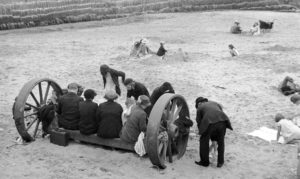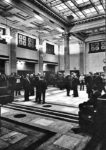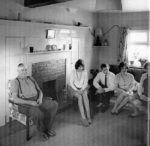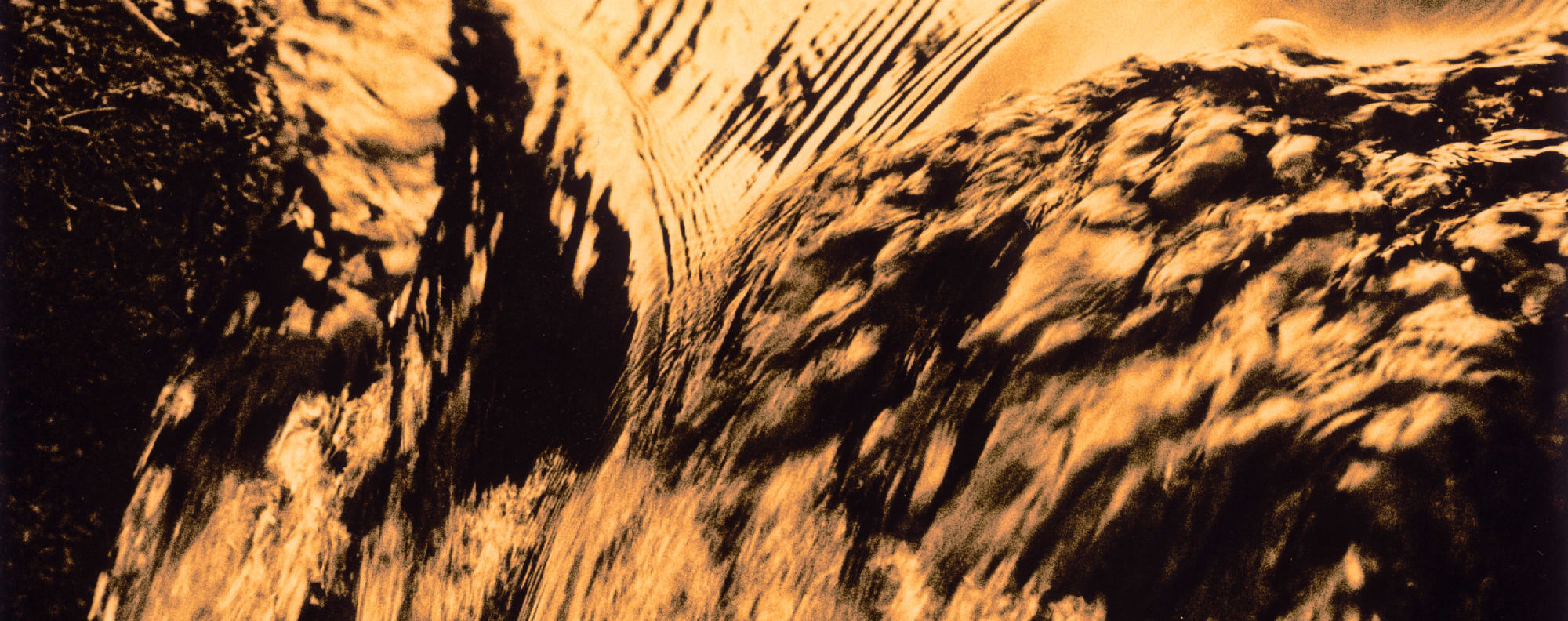
Very little of Smith’s work from the 1940s is included in the main sources used here, indeed the War and his chaotic lifestyle in this period (see ‘Edwin Smith – Unwrapping the Enigma’) reduced his photographic output. Less than one per cent of the four and half thousand photographs by Smith on the RIBA web site date from 1940-49.
In the 1950s and 1960s Smith’s photography concentrated on the architectural practice for which he is best known. People are the focus of attentions is some pictures from this period, e.g. ‘Mr and Mrs Joyce, Nunnery Somerset’ (1953) (ESP pl.126), ‘Fish and Chip Shop, Walworth, London’ (1959) (ESP pl 8), ‘East Street Market, Walworth, London’ (1961) (ESP pl. 40- shown at foot of last page) and ‘Mrs Margery Fish, Lambrook Manor, Somerset’ (1968) (ESP pl. 183). However, in the majority of pictures people are either entirely absent or are present in ones or twos to give context or scale and are very much secondary to the architecture – they are walk-on bit part players.
There are, however, two projects that hark back to the work done in the 1930s.


One hundred photographs were published in The Living City – A New View of the City of London (CL), commissioned by the Corporation of London and published in 1957. Here people feature in over three quarters of the photographs. There are intimate pictures of street life, e.g. ‘Leadenhall Market’ (CL pl. 72), but in crowds or large groups going about their business or attending functions predominate, e.g. ‘The Commodity Exchange’ (CL pl. 62). As the title of the book says, it is the City that is being documented, not the people.
In 1961 Edwin illustrated Olive Cook’s book A Study of Anstey – The Sense of Continuity in a Hertfordshire Parish (SA) as part of the campaign against the building of the Third London Airport at Nuthampstead. It contains 35 photographs, including first 28 landscape and architectural shots followed by seven of people at home, e.g. Thomas Sapsed and family (SA p. 56). As with The Living City, the sense from the book is that the people are incidental to the landscape and the place. The original material at RIBA does not dispel this impression.

Before evaluating Smith’s documentary photography it is helpful to sketch the context in which he was working.
Consider documentary photography in Britain. Compared with the United States and continental Europe, Britain does not have a strong early social documentary photographic history. However, there were several significant workers in a broad documentary field from the 1860s to the early years of the 20th century, including Benjamin Stone (1836-1914), John Thomson (1837-1921), Frank Meadow Sutcliffe (1853-1941), Peter Henry Emerson (1856-1956), Paul Martin (1864-1944) and Horace W Nichols (1867-1941).
If the first quarter of the century was a comparatively fallow period, the 1930s saw a prolonged flowering of documentary work. From 1931 Kurt Hutton was freelancing in London for the General Photographic Agency. Stefan Lorant and Felix H Man arrived in Britain in 1934 and the Weekly Illustrated was founded. Wolf Suschitzky arrived around the same time. In 1936 Bill Brandt photographed The English at Home; followed by photographs of miners in 1937 and A Night in London in 1938. George Rodger was a full time professional with the BBC from 1936 to 1939. Mass Observation was founded in 1937 and Humphrey Spender photographed Bolton (‘Worktown’), through to 1938, the year in which Edward Hulton founded Picture Post with Lorant as editor. Bert Hardy joined Picture Post in 1941 and was chief photographer until 1957. Rodger also worked for Picture Post and in 1947 was a founding member of Magnum Photos. In 1948 Brant published Camera in London. Roger Mayne came to London as a freelance photographer in 1954 and began to photograph in street markets and slum streets; in 1964 his commission “The British at Leisure” featured at the Milan Triennale. Patrick Ward came into reportage photography in the 1960s when the British Sunday newspapers were just starting their colour magazines. In 1966-67 Tony Ray Jones photographed ‘The English at Leisure’. Homer Sykes exhibited “Traditional Country Customs” at the ICA, London), in 1971.
This was a forty year period ‘in which photography’s highest calling was that of reporter and witness’ according to Ian Jeffrey (Photography: A concise History, p.214)
There is also an important non-photographic context. In the 1930s Britain was exposed to modernism in architecture and the arts: The Lawn Road Flats, Hampstead, designed by Wells Coates were built in 1933-34; and ‘Abstract and Concrete’, the first showing in England of international abstract art, was held in Oxford in 1936. The modern movement had its evangelical proponents and its conservative opponents, the latter based not only on aesthetic judgements, but also on a reaction against something that was seen as foreign. Both positions lead to an interest in the English vernacular. On the one hand it attempted to show that Britain had a tradition of functional design that went back centuries and the advent of functional modern architecture was heir to this and not a ghastly European plot. The more conservative tendency sought out meaning in details and trifles, in curlicues and a new interest in things Victorian. In the search for roots the two were not always as far apart as they may at first appear.
